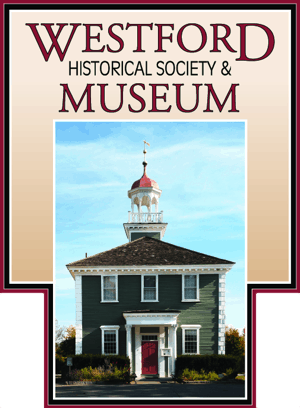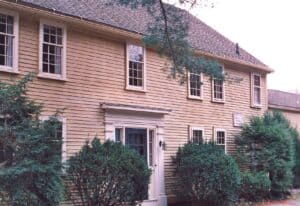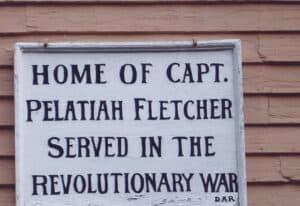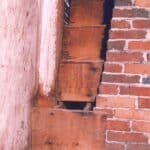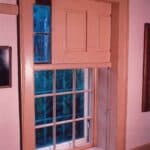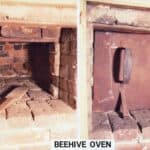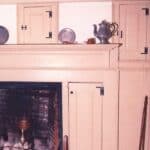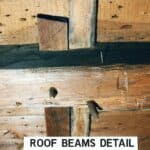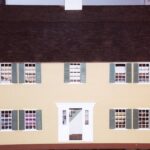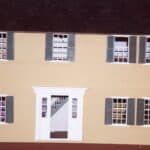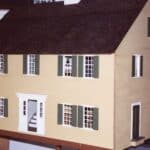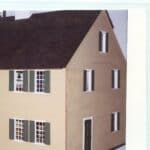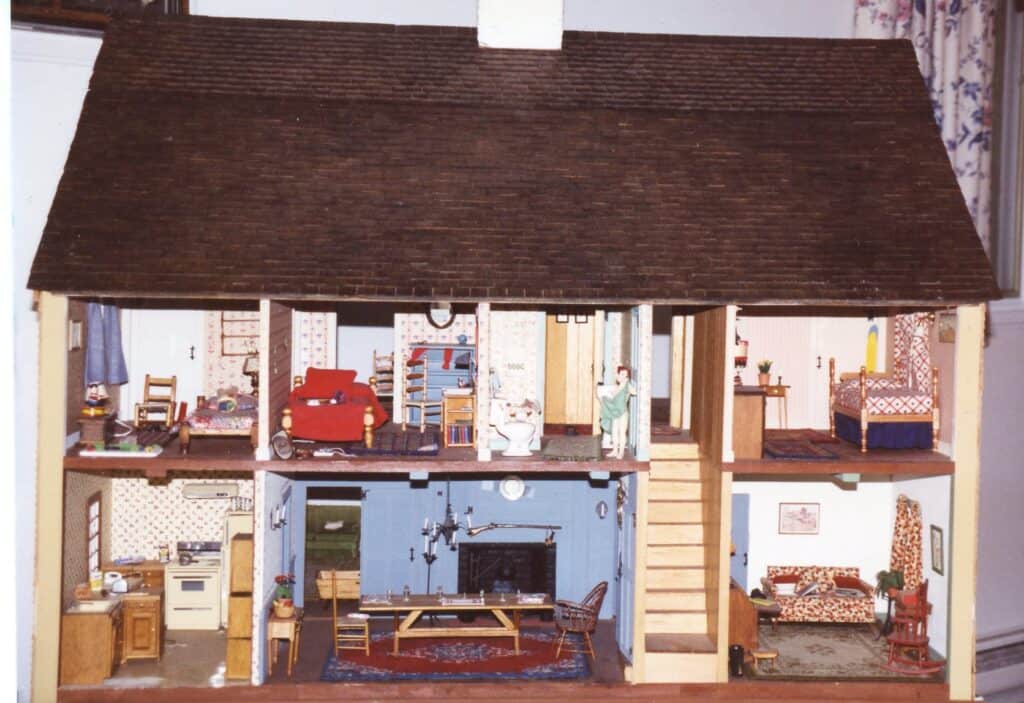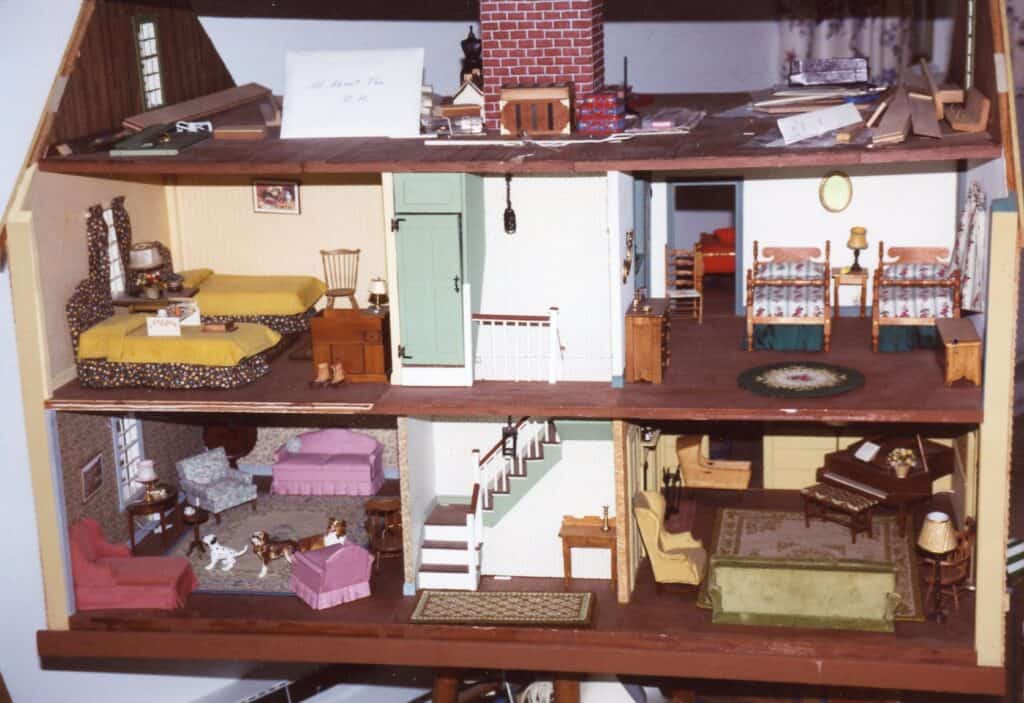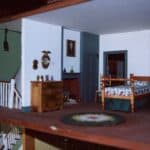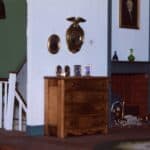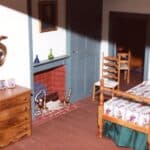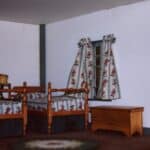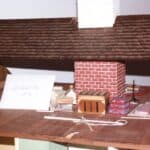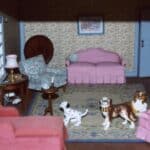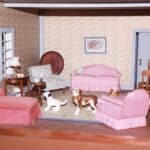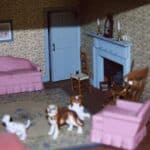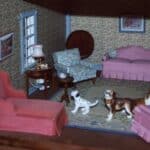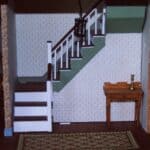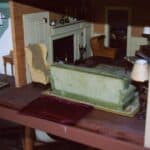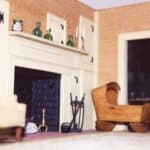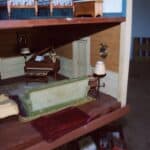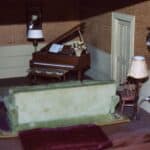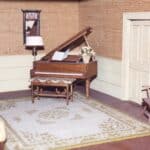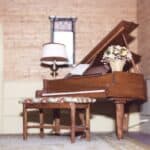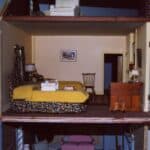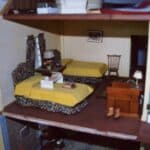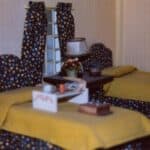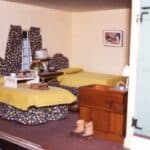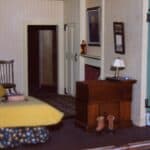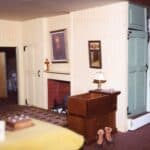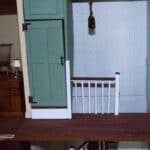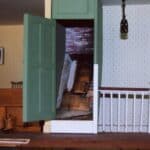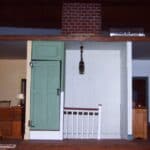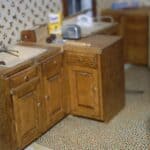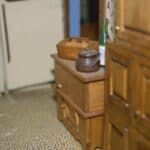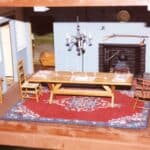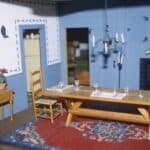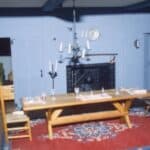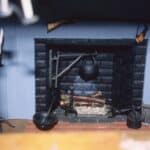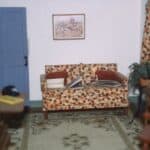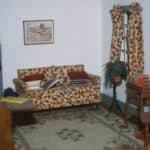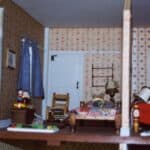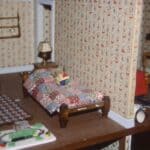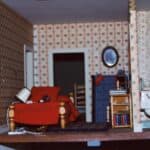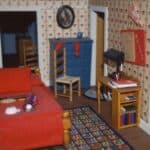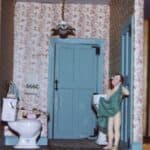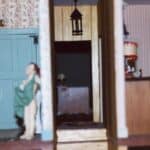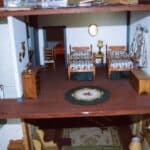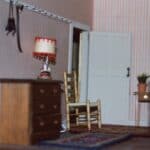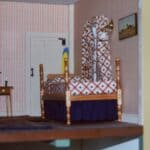The Doll House is no ordinary playhouse. After moving into the Captain Fletcher House (54 Lowell Rd), Mary “Marni” D. Agnew decided to create a replica of the house. The Fletcher House has many aspects typical of a Westford House, but also many other unique details. Some features are a beehive oven, Parson’s cupboard, and Indian Shutters. One of the most interesting parts of the house is the Witch’s Staircase. This staircase consists of one stair with missing planks in order to trip intruding witches. Marni’s efforts show an accurate example of what the house looked like and makes it truly come alive.
Doll-house of the Capt. Pelatiah Fletcher House
It was in 1955 that Mary D. Agnew moved to Westford to the Capt. Pelatiah Fletcher house on Lowell Road. “Marni,” as she was called, not only spent many years patiently and carefully restoring that house, but she also spent many years creating this dollhouse of Capt. Fletcher’s home, making sure that every detail was accurate and to scale. Marni’s sharp eyes missed nothing – did you find the tiny ice skates and hockey stick, the silverware, the telephone? Even hidden where you can’t see it, there’s a mouse in the kitchen cupboard.
When the Westford Historical Society was organized in 1975, Marni was among its first members. After her death in January 2001, her family, realizing Marni’s ties to the museum and her love of local history, offered to lend this doll-house to the museum so all visitors could share in its uniqueness
Mary, or “Marni” as she was called, was born 24 Jan. 1915 at Norwood, NJ, daughter of Frederick and Frances (Sweet) Dyer.The family relocated to the Lowell area where Marni graduated from Rogers Hall School in 1933. In 1943 she moved to Winchester. It was in 1955 that Marni moved into the Captain Pelatiah Fletcher house on Lowell Road, Westford which she carefully restored. She was active in the Col. John Robinson Chapter of the D.A.R. and the Westford Historical Society. At the time of her death in January 2001, Marni had four surviving sons: Robert M. McNitt, Jr., Hamilton K, Agnew, Arthur M. “Trey” Agnew III, and Jeffrey H. Agnew.
Pelatiah Fletcher House, Westford Massachusetts, Built c.1690
Mary “Marni” Agnew built this replica of the Pelatiah Fletcher House, 54 Lowell Road, Westford, MA. It is built to an exact 12:1 ratio. Marni, her husband Arthur, and their four children lived in this house from 1955 to 1966 at which time Mami built a new house in Westford Center. She started building this replica in 1982 and worked on it the rest of her life until 2001.
Marni Agnew built almost all of what you see here. She built the house: walls, floors, chimney, fireplace, and roof. She needle-pointed the rugs, stenciled the wainscoting, and built the furniture: the dry sink, trundle beds, tables and chairs.
Marni Agnew also had help from her sister, Ruth Wells. Ruth and her husband George Wells built Old Sturbridge Village in Southbridge, MA. Ruth and Marni loved early American history and culture, and felt the need to preserve it.
FEATURES OF THE HOUSE
The Pelatiah Fletcher House has many unique features: a “Witch’s Staircase”, “Indian Shutters“, a “Beehive Oven”, a “Parson’s Cupboard”, a 24-inch-wide board, and roof beams as tough as petrified wood! The beams were probably from the first cut of the forest and were the strongest wood. The house has five fireplaces, three on the first floor and two on the second.
The “Witch’s Staircase” is perhaps the most interesting feature of the house. When you open the attic door you see three steps and the chimney, and then more steps that turn to the right and go up to the attic. To the left of the chimney is another stairway about 10-12″ wide, but one of the planks is missing! The family believed that the witch who was traditionally nocturnal, and also had poor eyesight, would not notice this missing plank, trip and fall, hit her head on the attic door, and wake up the sleeping family who would then shoot her!
The first room (the Southeast room with the “Pelatiah Fletcher” plaque above it) was built around 1690 and had “Indian Shutters” designed to stop arrows. The walls in this part of the house are thicker, and inside the walls are sliding wood panels that pull out from the right side of the window to protect the window area and to help stop the arrows. As the house was expanded, these shutters were not used in any other part of the house.
A “Beehive Oven” is used for baking and is heated by the fireplace.
The “Parson’s Cupboard” is above the mantelpiece and was used to store the offerings to peripatetic ministers. It may have contained various religious books, writings and perhaps libations.
The “Weaving Room” (to the east side of the house as you face it) was an addition to the structure and was used for making clothes, dyeing fabrics, and sewing. This room was the largest room in the home. It is not part of the replica, but can be viewed for real on Lowell Road.
Under the chimney is a “Root Cellar” with a rounded roof (the base of the chimney). This area had a more relatively cool temperature than any other part of the house and would have been used for storage.
The room in the northwest comer of the house on the first floor is called the “Borning Room”. It was the warmest room in the house, close to the kitchen and dining room, received the afternoon sun from the west, and was dedicated to birthing and caring for the very young.
Until 1955, all of the inhabitants of this house got their water from a Dug Well, which was just a few feet from the house. The well had a bucket with a counter weight to help raise the bucket, but there wasn’t enough water for a family of six, so my father decided to dig an artesian well. The well drilling company drilled down through twenty feet of top soil and then hit granite for another 200 feet! We thought the drilling would never end! The water that they pumped up had high iron content and had to be treated with an elaborate filtering system in the basement in order to become potable.
Hamilton K. Agnew
July 12, 2007
The Doll House
Outside
Inside
The Rooms of the Doll House
MY RECOLLECTIONS
When I moved into the house in 1955, the floors were buckled from lack of heat. The house had no insulation, electrical wiring or plumbing system as we know them today. The previous owner, LuAnna DeCatur, had lived mostly in the parlor and kitchen areas, and could not maintain the house by herself in her latter years. In 1955 my father bought the house from LuAnna for $18,500. This included 13 acres behind the house and 75 acres of hills across the street, the tribal home of the Tadmuck Indians in the 1600’s.
I remember that my father brought an ice pick with him when we first looked at the house, and I asked him why he had brought it. He soon showed me by trying to jab it into one of the roof timbers in the attic to see how far in it would go. Hardly at all. .. these beams are solid!
There was hardly anything electrical in the house in 1955, and the electricians broke a lot of drill bits wiring the house due to the hardness of the wood, and it took them a very long time.
When I toured the house as an adult, I was surprised at how small it seemed. Not only was I a child when we lived there, but the people who built it were smaller in stature than we are today. You have to duck your head to walk around in the basement. The granite blocks of the foundation were quarried locally.
OTHER ITEMS OF INTEREST
Across the street and up the hill was the Tadmuck Indian’s Grist Mill. It is simply a large hole in a rock into which corn was put and ground with a pestle, which in this case was a large egg-shaped rock.
Hamilton K. Agnew
July 12, 2007
More of 54 Lowell Rd, Westford MA HERE.
